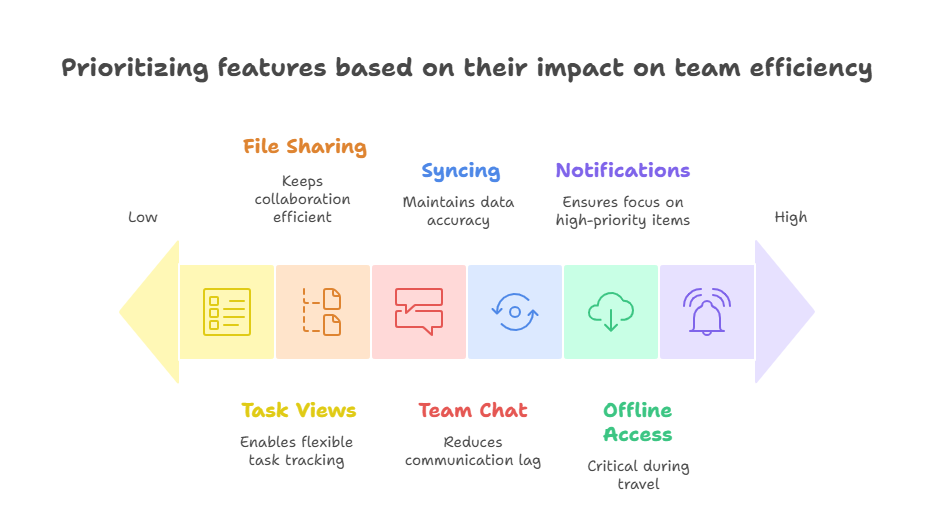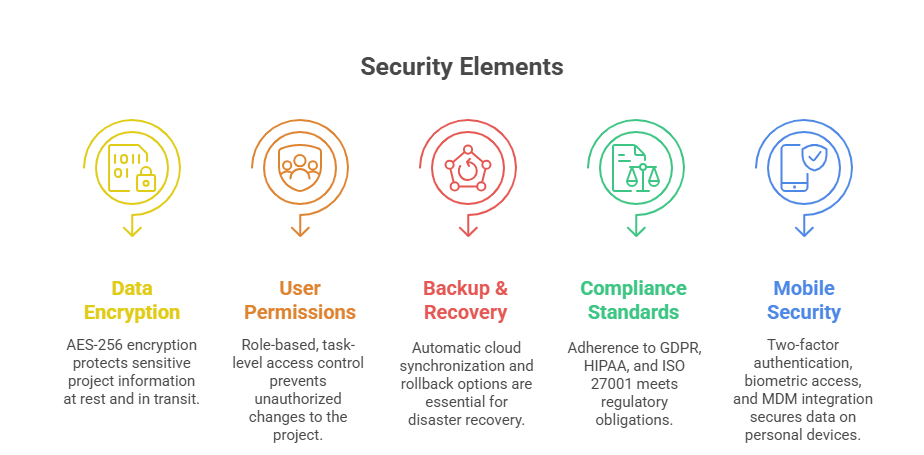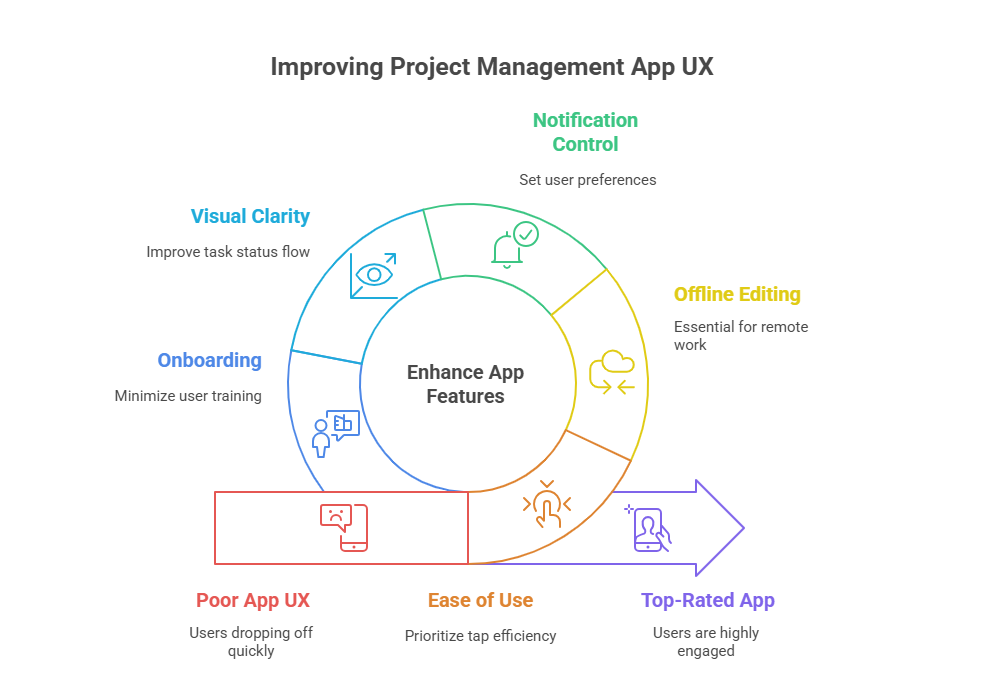Top 15 Project Management Mobile Apps for On-the-Go PMs
The project management world has shifted from desktops to on-the-go mobile workflows, driven by the rise of remote and hybrid teams. PMs no longer sit behind screens all day—today’s work demands coordination from airports, client offices, field visits, and even while commuting. Mobile project management (PM) apps are not secondary tools anymore; they’re now mission-critical for visibility, task tracking, and real-time collaboration. With mobile-first functionality baked into modern platforms, teams expect the same power and clarity on their phones as they do on desktops.
Whether you're handling agile sprints or managing a cross-functional roadmap, your mobile PM tool can make or break team momentum. But not every app is built equal. Some emphasize task flexibility, others champion integrations or offline capability. The right choice hinges on your role, workflow, and team scale. This guide ranks the top-performing mobile PM apps, breaks down must-have features, reviews real-world feedback, and shows how they align with practical certification frameworks like APMIC’s advanced project management training.
Features That Matter Most in Mobile PM Tools
Mobile PM apps aren’t just shrunken versions of desktop tools. For project managers in the field or in transit, only a few features truly drive execution-level value. This section breaks down the core capabilities that define a strong mobile project management experience—and how they influence real productivity, not just convenience.
Task Views, File Sharing, Team Chat, Syncing
Every mobile PM app must offer adaptive task views—Kanban boards, timelines, and checklists that adjust smoothly to small screens. The best tools allow for tap-to-edit speed and frictionless drag-and-drop, so updating task statuses doesn’t slow work down. File sharing should go beyond uploads: previewing documents, annotating PDFs, or version control are essential to keep reviews moving.
Built-in chat isn’t optional—it’s how decisions are made in real time. Whether you’re resolving blockers or aligning on deadlines, team communication within tasks shortens feedback loops dramatically. Lastly, syncing must be instant and reliable. Offline edits, when reconnected, should update across users without overwrites or missing changes—something only a handful of apps handle well.
Offline Access and Notifications
Mobile PM fails without offline functionality. When traveling or in low-signal environments, project managers still need access to timelines, key files, and checklists. The top-tier apps cache essential data, allow limited offline editing, and queue actions for auto-syncing once back online. Without this, productivity suffers the moment you lose signal.
Push notifications should strike a balance between relevance and urgency. Flooding users with low-priority pings leads to burnout. The ideal system offers granular control over alert types, letting PMs get notified only for updates on specific tasks, mentions, or deadlines. This enables immediate action—especially critical for blockers, delays, or approvals that require mobile responsiveness.
Security and Compliance Considerations
When project data lives on mobile devices, security isn’t optional—it’s foundational. A weak security layer in your PM app can expose sensitive client data, compromise financials, or violate regulatory frameworks like GDPR, HIPAA, or ISO 27001. Mobile project management must go beyond app locks and passwords—it needs a defense-in-depth approach to protect workflows without slowing teams down.
Data Encryption, User Permissions, Backups
The best apps encrypt all data both in transit and at rest, using 256-bit AES or stronger protocols. This ensures even if the data stream is intercepted, it remains unreadable. What separates top-tier platforms is end-to-end encryption across all devices, including offline-stored data on mobile.
User permissions need to go beyond admin vs member. Enterprise-ready PM apps support granular role assignments—like read-only access for clients, editing rights for leads, and restricted access to finance boards. This segmentation of data access helps minimize internal risk and ensures compliance with internal policies.
Backups are non-negotiable. Whether accidental deletion or device theft, mobile PM apps should automatically back up project data to secure cloud servers. Apps like ClickUp and Asana offer robust restore options—essential for regulatory audits or rollback scenarios.
Ranked List of 15 Best PM Mobile Apps
Not every project management app delivers a strong mobile-first experience. Some tools excel at dashboards but fall flat on notifications. Others shine in communication but lack offline access. This ranked list highlights 15 apps that balance core features, mobile performance, and user feedback—making them ideal for on-the-go project managers.
Trello, ClickUp, Asana, Wrike, Jira, Monday.com
Trello – Visual-first task boards with simple drag-and-drop make it great for fast-moving personal or team projects.
ClickUp – Highly customizable with subtasks, time tracking, and offline capabilities, ideal for remote Agile teams.
Asana – Excellent mobile layout and notification system. Ideal for workflows needing dependency tracking and timeline visualization.
Wrike – Known for its proofing and request forms, Wrike suits content, marketing, and enterprise teams with complex approval chains.
Jira – The default Agile toolkit, Jira’s mobile version retains burndown charts, sprint boards, and integration with Git tools.
Monday.com – Combines visual boards with automation and CRM tools. Its mobile dashboard is smooth and real-time collaborative.
More Top-Tier PM Apps
Notion – While not a traditional PM tool, it offers boards, databases, and calendar views all within a mobile-friendly UI. Great for solo managers or content teams.
Basecamp – Built for team collaboration with message boards and file storage. The mobile app is fast and cleanly structured.
Smartsheet – Spreadsheet-based PM with deep customization. Ideal for teams familiar with Excel-like structures and matrix reporting.
TeamGantt – Lightweight app focused on timeline visualization, perfect for event planners or milestone-based projects.
Microsoft Planner – Integrates well with Teams and Office 365. A mobile-first pick for Microsoft-centric teams with basic Kanban needs.
nTask – Affordable tool with time tracking, meeting management, and risk analysis tools, all accessible on mobile.
Zoho Projects – Best for users already in the Zoho ecosystem. Features built-in timesheets, Gantt charts, and task dependencies.
ProofHub – Combines task views with chat and discussions. A solid alternative for teams wanting an all-in-one mobile workspace.
MeisterTask – Lightweight but effective with customizable Kanban boards, automation rules, and time tracking.
Who Should Use What
Freelancers & consultants: Trello, Notion, or MeisterTask—simple, customizable, fast to deploy.
Agile developers: Jira and ClickUp—designed for iterative, sprint-based work.
Marketing & content teams: Asana, Monday.com, ProofHub—focus on visual boards, approvals, and real-time collaboration.
Enterprise PMs: Wrike, Smartsheet, or Zoho Projects—robust permissions, reporting, and multi-project oversight.
Event managers & planners: TeamGantt or Basecamp—great for scheduling and centralized communication.
| App Name | Best For | Key Mobile Features |
|---|---|---|
| Trello | Simple workflows | Visual Kanban, easy drag/drop |
| ClickUp | Complex Agile projects | Time tracking, offline sync |
| Asana | Mid-size teams | Dependencies, timeline views |
| Wrike | Enterprise users | Proofing, real-time Gantt |
| Jira | Agile development teams | Sprint boards, issue tracking |
| Monday.com | Cross-functional teams | Automation, visual UI |
| Notion | Solo managers, docs + tasks | Unified workspace, clean UI |
| Basecamp | Team communication | Message boards, docs |
| Smartsheet | Spreadsheet-style PM | Timeline views, integrations |
| TeamGantt | Event planners | Mobile Gantt chart UX |
| Microsoft Planner | Office 365 users | Basic Kanban, Outlook sync |
| nTask | Budget-conscious teams | Time/risk management |
| Zoho Projects | Zoho users | Gantt, billing, reporting |
| ProofHub | Creative teams | Chat, files, approval flow |
| MeisterTask | Visual thinkers, freelancers | Kanban, automation |
Price, Platform, and Compatibility Breakdown
The cost and platform compatibility of project management apps can be a deal-maker or deal-breaker, especially when scaled across teams. A mobile app may be feature-rich, but without a fair pricing model or cross-device consistency, it quickly loses relevance for project managers operating in mixed tech environments.
Android vs iOS Differences
Most PM apps today are available on both Android and iOS, but their performance can differ significantly. Android versions often receive faster hotfixes and broader file access, allowing easier storage integrations. iOS counterparts, however, generally offer smoother UX transitions and tighter security compliance, especially for apps like Monday.com or Asana.
Apps like ClickUp and Notion sync flawlessly across platforms with minimal UI differences. But others, like Smartsheet or Jira, occasionally lag in update parity—features may release earlier on one platform over the other. For BYOD (Bring Your Own Device) teams, this can disrupt workflows if critical features aren't universally available.
Mobile optimization also plays a role. On Android, multi-window split view or external keyboard compatibility enhances multitasking. On iOS, Handoff and Focus Mode integrations elevate task continuity, giving Apple users slightly better flow for deep work in mobile PM apps.
Free vs Pro Versions
Pricing structures vary, but most mobile-first PM tools operate on a freemium model. Trello, Asana, and Monday.com offer free versions with core functionality, but advanced features like timeline views, automations, and admin controls are locked behind paid tiers.
For small teams or individuals, free plans often suffice—especially with tools like MeisterTask or nTask. But scaling up demands better data control, integrations, and user permissions. ClickUp’s entry-level Pro plan is particularly attractive, offering unlimited dashboards, time tracking, and automation even in mid-tier pricing.
Zoho Projects and Wrike follow a modular pricing approach—charging per feature set or user count. This is ideal for enterprises wanting to customize access. Basecamp, by contrast, offers flat-rate pricing, which benefits larger teams with predictable budgeting.
When selecting your tool, consider not just the app’s sticker price, but how it aligns with team size, growth plans, and feature scalability across mobile and desktop platforms.
| Category | Android vs iOS | Free vs Paid |
|---|---|---|
| Update Timing | Android faster for fixes | Free: Basic features |
| UX Performance | iOS smoother animations | Paid: Timelines, integrations |
| File Permissions | Android more flexible | Paid: Guest access, reporting |
| Split Screen | Android supports multitasking | Paid: Admin controls |
| iOS Integrations | Strong with Handoff, iCloud | Free: Task creation, comments |
| Paid Plan Value | ClickUp, Asana, Monday strong | Flat-rate vs per-user varies |
User Experience and Real Feedback
Mobile project management isn’t just about tools—it’s about how tools feel under real-world pressure. A clean interface means nothing if a task update requires four taps. This section focuses on UX bottlenecks and real user sentiment, based on crowdsourced reviews and team feedback across industries.
Mobile UX Challenges for PMs
PMs working from mobile face constraints not present on desktop: smaller screens, touch input, slower typing, and distractions from other apps. Poorly designed interfaces waste time. Many users report frustration with cluttered dashboards, hard-to-hit buttons, and non-intuitive file structures—especially in apps that over-clone desktop layouts.
Lag during sync, dropdown menus that don’t expand properly, or lack of bulk task editing are top complaints. Apps like Jira and Smartsheet often receive mixed feedback here—they’re powerful but dense. By contrast, Notion, Trello, and ClickUp tend to prioritize gesture-based inputs and clean nesting, which drastically reduces user friction.
A successful mobile PM app must prioritize quick entry, clean task hierarchy, and snappy updates—even if it sacrifices some advanced controls in the process. The faster you can execute a workflow one-handed, the more likely the app becomes part of your daily rhythm.
Crowd-sourced Ratings and Reviews
App Store and Play Store reviews paint a brutally honest picture. Users consistently favor apps with:
<120MB install size
Fast load times
Offline access
Custom notification control
Quick-view widgets (especially on Android)
Trello, ClickUp, and Monday.com average 4.6+ star ratings across platforms. Trello earns praise for simplicity. ClickUp’s Pro version draws acclaim for deep features on mobile. Monday.com is appreciated for visual clarity and automation even on small screens.
Lower-rated tools often suffer from sync delays or desktop-first design bias. Wrike and Jira receive solid marks for power users but tend to frustrate casual or first-time users with their steep learning curves.
Enterprise IT forums, Reddit threads, and G2 reviews confirm the trend: most mobile PM users want a balance of power and tap-efficiency, not bloated feature sets. Apps that nail task flow in three steps or fewer get adopted quickly. Everything else gets offloaded to desktop.
APMIC’s Advanced PM Certification Covers These Tools
Project managers serious about tool mastery and mobile efficiency won’t just rely on trial and error. The Advanced Project Management Certification offered by APMIC is one of the few industry-recognized programs that directly integrates training on top-ranked mobile PM tools like Trello, ClickUp, Asana, and Jira—ensuring you're equipped to lead modern teams on any device, from anywhere.
This 542-lesson certification dives deep into real-world mobile workflows, including Agile sprint planning, resource allocation, and remote team communication using mobile-first platforms. Whether you’re syncing dashboards from ClickUp during a site visit or assigning Trello cards mid-client call, APMIC teaches efficient task navigation across mobile interfaces.
The course also addresses security, version control, and automation, guiding you through mobile-based approval workflows and dependency mapping. You’ll complete case-based modules that simulate real mobile use: from updating Gantt charts in Wrike during a conference break to resolving blockers through Monday.com’s chat threads while on a commute.
Graduates finish with hands-on exposure—not just theoretical frameworks—making them immediately job-ready for hybrid or remote-first organizations. Learn more or enroll directly at APMIC's Advanced PM Certification.
Frequently Asked Questions
-
Jira is the most popular mobile PM tool for Agile teams due to its native sprint planning, backlog grooming, and user story tracking. It supports Scrum, Kanban, and hybrid frameworks with mobile-specific boards. Teams can quickly update sprint statuses, assign tasks, and integrate with Bitbucket or Confluence from their phones. Alternatives like ClickUp also offer Agile templates and sprint views, making them suitable for smaller remote teams. What sets Jira apart is its deep configurability for larger dev teams, though it may require a steeper learning curve. If your Agile process involves daily standups, sprint retros, or velocity charts, Jira’s mobile app is the most comprehensive solution.
-
Yes. ClickUp, Asana, and Basecamp are known for offering robust offline functionality. These apps allow users to view, edit, and create tasks even without an internet connection. Once you reconnect, changes are automatically synced across devices, ensuring nothing is lost. Offline access is crucial for PMs working during travel, on-site inspections, or in poor connectivity zones. ClickUp even lets you track time and comment on tasks offline. Basecamp caches messages and documents for uninterrupted reading. Just make sure the app version is up to date, and you’ve allowed offline permissions in your phone settings to unlock full capability.
-
Choose based on your workflow complexity and team needs. Trello is best for simple task tracking using Kanban boards—it’s visual and ideal for freelancers or small teams. Asana adds features like timelines, dependencies, and built-in automation, making it better for teams juggling multiple projects. Monday.com stands out for its flexibility across use cases: CRM, marketing, and IT workflows, all with customizable boards. If you need visual simplicity: go Trello. For medium-sized teams needing coordination: choose Asana. For teams needing multiple views, integrations, and scalability: Monday.com is the most versatile, especially with its mobile automation triggers.
-
Yes—most top-rated PM apps include real-time collaboration through comment threads, @mentions, task updates, and instant notifications. ClickUp, Monday.com, and Asana shine in this area. You can leave comments on tasks, attach files, or tag teammates for quick feedback. These updates are synced across mobile and desktop instantly, so no one is left out of the loop. Wrike and ProofHub even include approval workflows within mobile dashboards. Trello supports real-time updates too, though without as many automation features. Always enable push notifications and mobile sync to ensure you receive changes in real time—especially for deadline-sensitive projects.
-
For Gantt-style timeline views on mobile, TeamGantt, Wrike, and Smartsheet lead the pack. TeamGantt is specifically built around timeline planning, allowing PMs to move tasks across dates with simple drag-and-drop gestures. Wrike offers interactive Gantt charts within its mobile app, letting users view dependencies and overlapping tasks clearly. Smartsheet provides a spreadsheet-style interface with timeline overlays, suitable for PMs who prefer Excel-like control. ClickUp and Asana offer timeline views as well, but their usability on smaller screens can feel cramped. If timeline management is your priority, TeamGantt offers the cleanest, most mobile-optimized experience.
-
Yes, but security varies by platform. ClickUp, Asana, Jira, and Wrike all support 256-bit encryption, secure login (including SSO), and granular user permissions. These apps are used by Fortune 500 companies and comply with SOC 2, ISO 27001, and in some cases, HIPAA. If your organization deals with confidential client data, always verify the app’s compliance certifications. Wrike and Jira offer audit logs and admin dashboards to monitor data access and changes. You should also enable 2FA (two-factor authentication) and use app-specific passwords for additional protection. For maximum security, pair mobile use with a secure MDM (Mobile Device Management) platform.
-
For individuals or small teams, yes. Trello, ClickUp, and Asana offer free tiers that include task creation, Kanban boards, and basic collaboration tools. However, features like timeline views, automations, guest permissions, and reporting often require paid upgrades. For example, Trello’s free plan is generous but limits Power-Ups (integrations), while ClickUp offers nearly unlimited tasks and users—even in its free version. If you manage clients, need time tracking, or want multiple project views, the Pro or Business tiers are worth the investment. Choose free plans to start—but expect to scale into paid versions as your team and workflow complexity grow.
-
Trello is by far the easiest. It’s visual, intuitive, and has a shallow learning curve—making it ideal for onboarding non-technical team members. New users can drag cards, add checklists, or move tasks without training. Monday.com is a close second; its templates and tooltips help users adapt quickly. ClickUp and Jira are powerful but require more setup and orientation. If your team is composed of freelancers, clients, or non-PM roles, choose a platform that minimizes steps and supports self-guided learning. Look for mobile onboarding tutorials, pre-built templates, and simple workspace hierarchies for faster team alignment.
Our Verdict
Mobile project management has evolved from being a secondary convenience to a primary workflow engine for remote-first and hybrid teams. Whether you're updating a sprint backlog from a train or approving a client asset between meetings, the right mobile app turns downtime into high-leverage execution. But not all tools are equal.
Apps like ClickUp, Asana, and Monday.com provide the perfect balance of usability, power, and offline control. For Agile teams, Jira’s mobile suite remains unmatched. Simpler options like Trello or MeisterTask are ideal for lightweight coordination. The best app for you depends on your workflow complexity, device ecosystem, and team habits. But one thing is clear: investing in mobile-ready PM tools isn’t optional—it’s how great project managers stay two steps ahead, anywhere, anytime.




